

Ricci albenda. Slavs and Tatars. Cevdeterek. Nilbar Gueres. Hans Haacke. Hans Haacke Deichtorhallen, Hamburg, Akademie der Künste, Berlin, Germany Since his poignant installation at the 1993 Venice Biennale, in which he smashed up the marble floor of the German pavilion as an aggressively fractured monument to his homeland, Hans Haacke has become a bankable designer of public memorials.
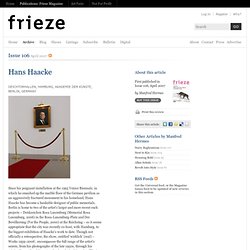
Berlin is home to two of the artist’s larger and more recent such projects – Denkzeichen Rosa Luxemburg (Memorial Rosa Luxemburg, 2006) in the Rosa-Luxemburg-Platz and Der Bevölkerung (For the People, 2000) at the Reichstag – so it seems appropriate that the city was recently co-host, with Hamburg, to the biggest exhibition of Haacke’s work to date. Haacke’s interest in closed physical systems, biological growth and random movements manifested itself in works such as Condensation Cube (1963–5), a moisture-filled Plexiglas con-tainer whose appearance altered constantly in relation to its environment. Manfred Hermes. Christoph Büchel: Simply Botiful. Abraham Cruzvillegas. Found and Lost Monograph For over a decade Mexican artist Abraham Cruzvillegas has made sculptures from objects as disparate as cake, scythes, boxes, plants and magazines There remains, of course, the problem of the material of some objects.
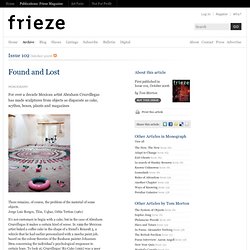
Jorge Luis Borges, Tlön, Uqbar, Orbis Tertius (1961) It’s not customary to begin with a cake, but in the case of Abraham Cruzvillegas it makes a certain kind of sense. For all the impact of modernity, our species still engages in many types of productive activity that know nothing of Fordian or post-Fordian methods. Abraham Cruzvillegas’ early works date from the beginning of the 1990s. Looking at Cruzvillegas’ sculptures, I keep returning to the same question: does a ‘found object’ know (somewhere in its morphic field, perhaps?)
Before moving from Mexico to France in 2005, Cruzvillegas was faced with a problem: what to do with the 500 or so objects – some useful, some not – that were cluttering his soon-to-be-vacated studio? Tom Morton. Tara Donovan. Tara Donovan builds large, labor-intensive, and site-specific installations out of everyday materials such as scotch tape, drinking straws, paper plates, roofing paper and Styrofoam cups.
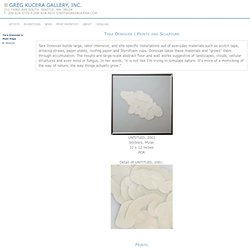
Donovan takes these materials and "grows" them through accumulation. The results are large-scale abstract floor and wall works suggestive of landscapes, clouds, cellular structures and even mold or fungus. In her words, "it is not like I'm trying to simulate nature. It's more of a mimicking of the way of nature, the way things actually grow. " Latifa Echakhch. Latifa Echakhch Galleria Francesca Kaufmann, Milan, Italy Latifa Echakhch, Les petites lettres (2009) In 1951, Milan’s Triennale held an international congress on La Divina Proporzione (Divine Proportion) and asked Le Corbusier to chair it; two years before, the Swiss master had published his first version of Modulor Man, a system based on the golden ratio, Vitruvius, Alberti and Leonardo, which he defined as a ‘harmonious measure to the human scale, universally applicable to architecture’.
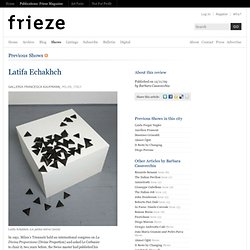
At Francesca Kaufmann, Latifa Echakhch uses the system’s standard dimensions as compositional tools for a series of four wall drawings, covering the white and vaulted small secondary exhibition space in thick charcoal. Koo jeong-a Images. Ruben Ochoa. Tomás Saraceno. Felix schramm images. Aleana Egan. Brendan Earley, Artist. Brianduggan. David Beattie. Evelyn O'Connor. Joel Shapiro. Joel Shapiro first came to widespread public attention in the early 1970s at a time when it seemed sculpture needed to redefine itself after the Minimalist and Conceptual extremes of high modernism.
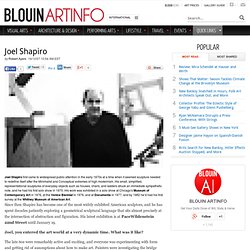
His small, simplified, representational sculptures of everyday objects such as houses, chairs, and ladders struck an immediate sympathetic note, and he had his first solo show in 1970. His work was exhibited in a solo show at Chicago's Museum of Contemporary Art in 1976, at the Venice Biennial in 1976, and at Documenta in 1977, and by 1982 he’d had his first survey at the Whitney Museum of American Art. Since then Shapiro has become one of the most widely exhibited American sculptors, and he has spent decades patiently exploring a geometrical sculptural language that sits almost precisely at the intersection of abstraction and figuration. His latest exhibition is at PaceWildenstein 22nd Street until January 19. Joel, you entered the art world at a very dynamic time. Such as? White Cube Gallery. Ryan Sarah Murphy. Frances Stark. Carlito carvalhosa. Martin Creed Home. Shuli Sadé.